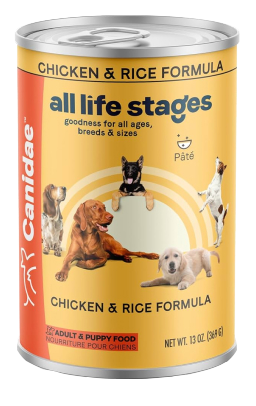
DogFoodAdvisor is reader supported See how
All reviews are 100% impartial but if you buy using links on this page, we may earn a referral fee.
Our Verdict
Canidae All Life Stages Canned product range is made up of four recipes with ratings varying from 3 to 4.5 stars. The average rating of the whole range is 4.5 stars.
The table below shows each recipe in this range including our rating and the AAFCO nutrient profile: Growth (puppy), Maintenance (adult), All Life Stages, Supplemental or Unspecified.
Recipe and Label Analysis
Canidae All Life Stages Chicken and Rice was selected to represent the other products in the line for detailed recipe and nutrient analysis.
Canidae All Life Stages Chicken and Rice
Estimated Dry Matter Nutrient Content
Protein
Fat
CarbsCarbohydrates
Chicken, chicken broth, chicken liver, brown rice, oat bran, carrots, peas, potatoes, guar gum, sunflower oil (source of omega-6 fatty acids), flaxseed oil (source of omega-3 fatty acids), carrageenan, dicalcium phosphate, choline chloride, salt, potassium chloride, cranberries, kelp, rosemary extract, yucca schidigera extract, zinc proteinate, iron proteinate, vitamin E supplement, copper proteinate, manganese proteinate, sodium selenite, thiamine mononitrate, cobalt proteinate, niacin supplement, D-calcium pantothenate, vitamin A supplement, riboflavin supplement, biotin, vitamin B12 supplement, potassium iodide, pyridoxine hydrochloride, vitamin D3 supplement, folic acid
Fiber (estimated dry matter content) = 1.5%
Red denotes any controversial items
| Estimated Nutrient Content | |||
|---|---|---|---|
| Method | Protein | Fat | Carbs |
| Guaranteed Analysis | 9% | 7% | NA |
| Dry Matter Basis | 41% | 30% | 22% |
| Calorie Weighted Basis | 31% | 53% | 16% |
Ingredients Analysis
The first ingredient in this dog food is chicken. Chicken is considered “the clean combination of flesh and skin… derived from the parts or whole carcasses of chicken”.1
Chicken is naturally rich in the ten essential amino acids required by a dog to sustain life.
The second ingredient is chicken broth. Broths are of only modest nutritional value. Yet because they add both flavor and moisture to a dog food, they are a common component in many canned products.
The third ingredient is chicken liver, an organ meat sourced from a named animal and thus considered a beneficial component.
The fourth ingredient is brown rice, a complex carbohydrate that (once cooked) can be fairly easy to digest. However, aside from its natural energy content, rice is of only modest nutritional value to a dog.
The next ingredient is oat bran, a nutritious by-product obtained from milling whole grain oats. The bran is the fiber-rich outer layer of the grain containing starch, protein, vitamins and minerals.
The sixth ingredient lists carrots. Carrots are rich in beta-carotene, minerals and dietary fiber.
The next item is peas. Peas are a quality source of carbohydrates. And like all legumes, they’re rich in natural fiber.
However, peas contain about 25% protein, a factor that must be considered when judging the meat content of this dog food.
The eighth ingredient is potatoes. Potatoes can be considered a gluten-free source of digestible carbohydrates. Yet with the exception of perhaps their caloric content, potatoes are of only modest nutritional value to a dog.
The ninth ingredient is guar gum, a gelling or thickening agent found in many wet pet foods. Refined from dehusked guar beans, guar gum can add a notable amount of dietary fiber to any product.
From here, the list goes on to include a number of other ingredients.
But to be realistic, items located this far down the list (other than nutritional supplements) are not likely to affect the overall rating of this product.
With four notable exceptions…
First, flaxseed one of the best plant sources of healthy omega-3 fatty acids. Provided they’ve first been ground into a meal, flax seeds are also rich in soluble fiber.
However, flaxseed contains about 19% protein, a factor that must be considered when judging the actual meat content of this dog food.
Next, this recipe contains sodium selenite, a controversial form of the mineral selenium. Sodium selenite appears to be nutritionally inferior to the more natural source of selenium found in selenium yeast.
We also note carrageenan is a gelatin-like thickening agent extracted from seaweed. Although carrageenan has been used as a food additive for hundreds of years, there appears to be some recent controversy regarding its long term biological safety.
The article, The Carrageenan Controversy, published in Scientific American, does a good job of addressing this topic.
And lastly, this food includes chelated minerals, minerals that have been chemically attached to protein. This makes them easier to absorb. Chelated minerals are usually found in better dog foods.
Nutrient Analysis
Based on its ingredients alone, Canidae All Life Stages canned dog food looks like an above-average wet product.
The dashboard displays a dry matter protein reading of 41%, a fat level of 30% and estimated carbohydrates of about 22%.
As a group, the brand features an average protein content of 36% and a mean fat level of 26%. Together, these figures suggest a carbohydrate content of 30% for the overall product line.
And a fat-to-protein ratio of about 87%.
Which means this Canidae product line contains…
Near-average protein. Above-average fat. And above-average carbs when compared to a typical wet dog food.
Free of any plant-based protein boosters, this looks like the profile of a wet dog food containing a notable amount of meat.
Canidae Dog Food Recall History
The following automated list (if present) includes all dog food recalls related to Canidae through December 2025.
You can view a complete list of all dog food recalls since 2009 here.
Our Rating of Canidae All Life Stages Dog Food
Canidae All Life Stages is a grain-inclusive canned dog food using a notable amount of named meats as its main source of animal protein, thus earning the brand 4.5 stars.
Compare Canidae All Life Stages Dog Food
How does Canidae All Life Stages compare with The Dog Food Advisor's most recommended brands?
A Final Word
The Dog Food Advisor does not accept money, gifts, samples or other incentives in exchange for special consideration in preparing our reviews.
However, we do receive a referral fee from online retailers (like Chewy or Amazon) and from sellers of perishable pet food when readers click over to their websites from ours. This helps cover the cost of operation of our free blog. Thanks for your support.
For more information, please visit our Disclaimer and Disclosure page.








